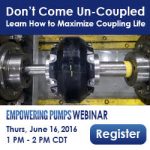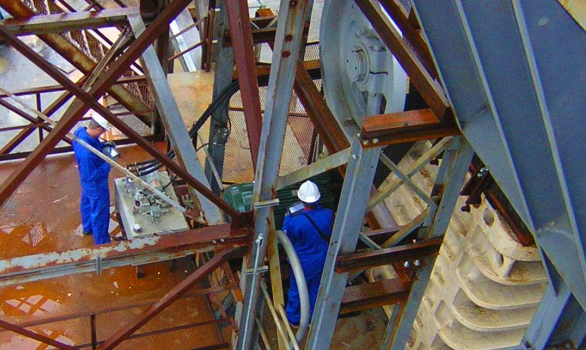Authors: Matthew Wolford, Product Manager, and Alex Vitou, Development Engineer, Baldor Electric Company
When people talk about “maximizing the life” of a piece of equipment, they are really talking about doing everything that can be done to get the most for their money. When you buy a coupling, for example, you want it to work well for as long as possible so you don’t have to spend more money to replace that coupling. In order to make sure your coupling works well for a long time, you first have to know what can be done to maximize the life of that coupling.
Maximizing coupling life involves proper selection, accurate installation, intended operation, and preventive maintenance.
Proper Selection
There are two main types of couplings: elastomeric and metallic. Elastomeric couplings are generally installed in power transmission systems that have smaller bore sizes and lower torque; while metallic couplings are typically used for bigger bores and higher torque.
To select the right coupling for your power transmission equipment, make sure you have all the correct application information. Critical information required for the selection process includes having your driver power, driver speed, shaft sizes for both your driver and your driven equipment, and details about the application itself, which helps determine the service factor for the coupling and allows you to calculate the torque. All of this information helps you understand whether you need a metallic coupling or an elastomeric coupling.
Let’s assume you have an ANSI style pump, driven by an electric motor, and you have determined that you need an elastomeric coupling. There are many styles of elastomeric couplings – tire style, sleeve style, jaw style, etc. – so how do you choose between them? This is when you consider additional factors, such as system alignment, vibration, and accessibility for maintenance.
Elastomeric couplings are generally capable of accommodating more misalignment than metallic couplings. Each style of elastomeric coupling can function within a specified range of misalignment; but if the misalignment is outside the specified limits, the life of the coupling or the components in the connected system can be greatly diminished.
There is usually some amount of vibration in every pumping system, so it is important to take that into consideration when selecting a coupling. There are some styles of elastomeric couplings that are designed to function well with more vibration, having the ability to dampen that system vibration and handle potential shock loads.
Accessibility for maintenance purposes can be another determining factor when choosing a coupling. The room that is available in the physical space plays a role in the selection process. For example, when a maintenance crew needs to access a pump, to pull the impeller or perform field service, a longer spacer distance between shaft ends can prevent the need to realign the equipment when it’s time to put everything back together. In this case, a spacer design would be needed to support the larger distance between the two shaft ends. If the amount of physical space is not an issue, and the ends of the shafts are really close together, then a close-coupled design will likely be an option to consider during the selection process.
Accurate Installation
Once you have properly selected your coupling, follow the recommended practices in the installation and operation manual. Alignment is really important during the installation process. The better aligned the two shafts are, the longer life you will see out of your couplings AND your connected equipment.
Preventive Maintenance and Troubleshooting
It is always a good idea to have a condition monitoring program in place, so you can inspect your equipment at regular intervals and see the health of your couplings over time.
For the main styles of elastomeric couplings that are commonly used with pumping equipment, there are some pretty signature visual signs of damage or failure. Knowing what to look for and how to read these signs can provide you with indications of the most common causes for coupling failure.
Should you have a coupling failure, what are some of the things to look at in that failure in order to get an understanding about what might have occurred? How do you determine what changes need to be made to correct the issue?
For answers to these questions, participate in our webinar June 16th to learn more about failure modes and best practices for preventing coupling failure.
 This webinar will be held on June 16th, 2016, from 1:00 p.m. to 2:00 p.m. CDT. If you have any questions about this webinar, please contact Charli K. Matthews at charli@empoweringpumps.com. We look forward to your participation!
This webinar will be held on June 16th, 2016, from 1:00 p.m. to 2:00 p.m. CDT. If you have any questions about this webinar, please contact Charli K. Matthews at charli@empoweringpumps.com. We look forward to your participation!
To receive updates on other webinars or industry training events, subscribe to our Enewsletter.




